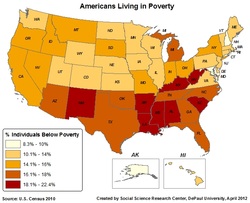A Nexus: MLK and the State of Poverty in America
What many do not know is that MLK Jr. spent the last several months of his life working on a campaign to raise awareness about the state of poverty in the United States. “According to accounts of the day retold by Jesse Jackson and Martin Luther King III, King spent the day working on a campaign that he hoped would force Washington and the American public to acknowledge and resolve the problem of poverty for people of all races, religions and backgrounds in the United States. The Poor People’s Campaign was the agenda for the day, with a short break for birthday cake.” Today, forty-six years after his death, we continue the battle against poverty, albeit with mixed results.
According to the U.S. Department of Health and Human Services, 2013 Poverty Guidelines , which present estimates for the number of Americans living in poverty each year, suggest that a family of four is considered to be living in poverty if its annual income is $23,550 or less. Based on this calculation, 15% of Americans (or approximately 47.4 million Americans) lived on or below the poverty threshold in 2013. One should note that this calculation does not take into account government benefits, nor the effects of medical and work expenses on the cost of living, nor is it adjusted for regional differences in housing costs. When adjusted for these factors, the figure rises to 16.1%, or 51 million Americans.
Of course, poverty affects demographics differently. Minorities, children, and individuals living with disabilities are affected at disproportionately higher rates. Below are a few statistics according to a 2012 study released by the School of Public and Environmental Affairs at Indiana University Bloomington:
As of 2010, using the measurement of the official poverty measure, here is a breakdown of poverty according to racial and ethnic lines:
· African Americans had the highest rate of poverty (27.4%), followed by
· Hispanics, (26.6%),
· Asian Americans, (12.1%), and
· Whites (9%)
… the breakdown according to age groups:
· Children under 18 had the highest official poverty rate (22%), followed by
· Persons 18-64 yrs old (13.7%), and
· Persons 65 yrs and older (9.0%)
This January marks the 50th anniversary of what President Lyndon B. Johnson coined the ‘War on Poverty.’ After reading these statistics, one might ask, “How successful have we been as a society in reducing poverty?” Jared Bernstein contributed an interesting piece in the New York Times, the gist of which is as follows: Overall, the so-called ‘safety-net’ policies such as food stamps, unemployment benefits, the earned income tax credit, and housing subsidies have made a substantial impact in decreasing the rate of poverty. In 2012, the rate of poverty rate was approximately 15%–absent the aforementioned policies the rate would have been closer to 29%. Therefore, a logical conclusion would be that these policies lifted 14% of the population or approximately 42 million people out of poverty.
Nonetheless, a figure of 15% of America’s population living below the poverty line seems incredibly high for a developed country with the resources that America has at its disposal. Why is our safety net not more effective, or are other forces at work? Consider the following positive factors that have reduced poverty in the last fifty years: an increased share of adults with higher educational attainment, reduced family size, and a significantly larger share of women who are in the paid labor market. However, factors such as income inequality have risen as a result of ‘globalization, deunionization, lower minimum wages, slack labor markets and decreasing returns to lower-end jobs,’ according to Bernstein. An Economic Policy Institute study suggests that rising inequality between 1979 and 2007 was the single most important factor in increasing poverty by 5.5 percentage points. Ultimately: the data show that anti-poverty policies have been effective, but they’ve had to work harder in the face of increasing economic challenges facing low-income families.
Is there a solution? Earlier this year The Stanford Center on Poverty and Inequality issued a ‘national report card’ in which the center concluded that increased poverty, and a rising rate of wealth inequality, income inequality, as well as educational and health inequalities are of substantial concern. We as a society must address the failure of an economy to deliver jobs; a problem that generates excessive poverty and exposes the safety net to demands well beyond its capacity to meet them.
In spite of this reality, on January 14, 2014 Congress failed to pass legislation to extend unemployment insurance benefits. As a result, 1.3 million workers who lost their unemployment benefits at the end of December are unsure if and when this last bit of financial security will be reinstated. Yet another testament to the notion that our governing institutions cannot set aside partisan differences in order to resolve a problem that threatens to erode the fabric of our society.
Clayborne Carson, Director of MLK, Jr. Research and Education Institute has spent most of his professional life studying King’s writings and speeches. According to Carson, had Dr. King lived to see how far America has come in the fight against poverty in the last 50 years and where we stand today, he might say “Like racism, the problems associated with poverty are like weeds that will spread when left ignored,” said “He would remind us that poverty and economic inequities threaten the future of American democracy.”

